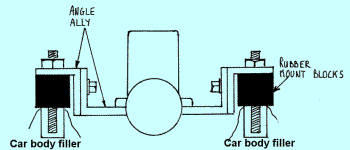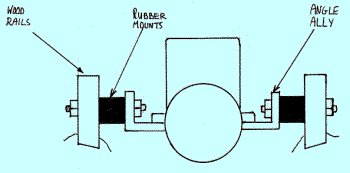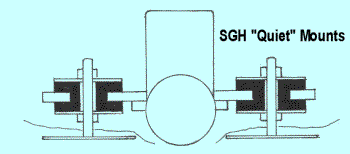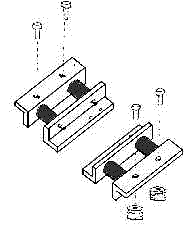| GLOW ENGINE MOUNTS |
|
Engine
installation is a chapter on it's own. It's hard to say what mount is
the best as each boat will have it's own particular requirements but
the diagrams below give a few ideas. If possible fit a flexible or rubber mount as it
kills most engine vibration and is easier on both hull, bearings, shaft
and the ears. An IC engine installation is vitally important to
get right, not only because of the required shaft alignment but
because it also involves setting the boats centre of gravity and shaft
down angle. The mount needs to be rigid, removable and robust. You are
going to pull very vigorously on this thing while starting so make
sure it's very strong. After the boats layout has been mapped
out, the engine, mounting and shaft should be the first thing fitted
and the rest of the boat built around it. Don't forget to leave room
for the starting belt under the flywheel during setting out. |
|
|
|
|
|
After you are happy with the dry alignment, wait till the next
day before starting to glue it in. This gives you a
chance to think through everything again before committing yourself.
Try applying tiny amounts of glue (or whatever fixer you
are using) on the critical points of the mount and shaft
to just 'tack' them in place which enables you to see if
corrections need to be made. Use lots of glue during the final fix
down of the engine mount to make it really strong, it will need it!!. When you've
finished, coat the engine room with gel coat or a glazing resin to
make the boat easier to clean.
|
| COUPLINGS ( Flexy shaft ) |
|
Rubber couplings are the most popular coupling used in sports and race boats because they are quiet in operation and allow for the movement of the flexible mount and engine vibration while starting and running. They come with different screw on adapters to allow for different engine and shaft sizes. Suppliers of multi boat equipment are the best source for rubber couplings and also flexible engine mounts. There are a few other type of couplings such as flexible disk and coiled spring but I personally don't like these types, the former in very large and prone to wear and the latter often spins eccentrically. Flexible shafts must use rigid couplings to prevent whiplash. These couplings come in three guises, (1) collet chuck, (2) solid block with grub screws and (3) solid block with square hole and shaft end. Type 3 is the easiest type but only TM products of Chatteris seem to supply them in the UK but there are several in the USA. The stuffing tube for flexi shaft should be made to follow a graceful gentle curve to minimize power losses through friction.
|
|
(1)
Collet chuck
See also... |
| PROPS |
|
With the engine installed and the coupling and shaft carefully lined up, fit a suitably sized propeller for you engine (check the engine instructions or an engine book for sizes) and leave a small gap between the propeller nut and the end of the prop tube to prevent binding. A clearance gap between the stuffing box and washer, more than 1mm is too much on a solid shaft but flexi shafts require as much as 2mm as the shaft expands in diameter under centrifugal force which draws the ends in. Try to get the outboard end of the prop shaft or strudder, in the case of a surface drive, to take the thrust load instead of the engine. A Teflon, hard plastic washer or stainless steel behind the prop nut makes a good enough thrust bearing for sports boats. Keep the washers as small as possible to reduce drag and don't forget to oil or grease the shaft and tighten the propeller lock nut.
Metal props are better than plastic ones as they don't change their
blade shape under load. Metal props apart from aluminium ones require
proper balancing to prevent vibration. I mainly use plastic
propellers as a whole range can be bought for the price of one metal
prop. When one of my plastic prop breaks, I just "Tsk", change
it and carry on boating at very little extra cost.
Plastic props are good enough for sports boaters but if you
want to go racing the metal props may
well be worth the investment.
Graupner and
Robbe
make the best plastic props.
|
| Also have a look at.... |
|
Well all of this is just
my opinion, but what do I know!
|






